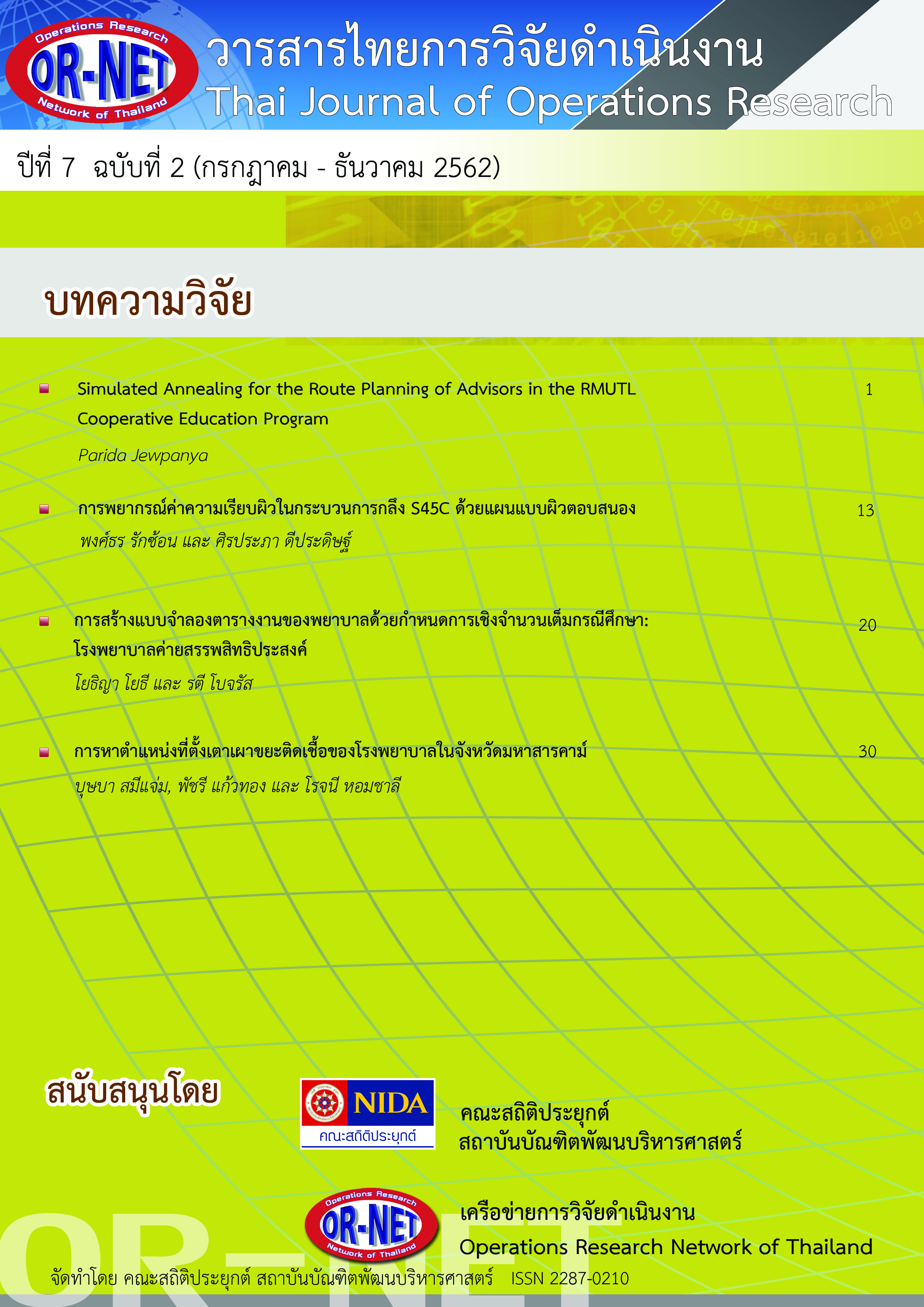Simulated Annealing for the Route Planning of Advisors in the RMUTL Cooperative Education Program
Keywords:
Cooperative education program;, simulated annealing heuristic, mixed-integer linear programmingAbstract
The Rajamangala University of Technology Lanna (RMUTL) is Thailand's leading university in the field of science and technology. The university focuses on producing graduates who are ready for workplaces through a hands-on learning system. RMUTL incorporates a Cooperative Education Program (CO-OP) in the learning system which aims to gives students an opportunity to receive career training in industries. The students in the final academic year are required to attain this program for a semester to be prepared for the workplace. During the students’ internship period, the RMUTL CO-OP has a team of advisors who need to visit those students in the industries at least two times to give the students advice on their projects and working life. The current visiting plan is created based on the planner experience which sometimes ineffective in term of costs. Therefore, in this study, a mixed-integer linear programming model is formulated to help the planner find an optimal route for the advisors. The objective is to minimize the total cost of the advisor's visitation. Moreover, we propose a simulated annealing heuristic (SA) to solve the problem. We generate benchmark instances and solved them by SA. Computational results show the excellent performance of SA in terms of solution quality and computational efficiency.
References
2. Blair, B.F., M. Millea, and J. Hammer, The impact of cooperative education on academic performance and compensation of engineering majors. Journal of Engineering Education, 2004. 93(4): p. 333-338.
3. Thiel, G.R. and N.T. Hartley, Cooperative education: A natural synergy between business and academia. SAM Advanced Management Journal, 1997. 62(3): p. 19.
4. Barbarosoglu, G. and D. Ozgur, A tabu search algorithm for the vehicle routing problem. Computers & Operations Research, 1999. 26(3): p. 255-270.
5. Eksioglu, B., A.V. Vural, and A. Reisman, The vehicle routing problem: A taxonomic review. Computers & Industrial Engineering, 2009. 57(4): p. 1472-1483.
6. Christofides, N., The vehicle routing problem. Revue française d'automatique, informatique, recherche opérationnelle. Recherche opérationnelle, 1976. 10(V1): p. 55-70.
7. Desrochers, M., J. Desrosiers, and M. Solomon, A new optimization algorithm for the vehicle routing problem with time windows. Operations research, 1992. 40(2): p. 342-354.
8. Laporte, G., The vehicle routing problem: An overview of exact and approximate algorithms. European journal of operational research, 1992. 59(3): p. 345-358.
9. Toth, P. and D. Vigo, Models, relaxations and exact approaches for the capacitated vehicle routing problem. Discrete Applied Mathematics, 2002. 123(1-3): p. 487-512.
10. Kek, A.G., R.L. Cheu, and Q. Meng, Distance-constrained capacitated vehicle routing problems with flexible assignment of start and end depots. Mathematical and Computer Modelling, 2008. 47(1-2): p. 140-152.
11. Schrage, L., Formulation and structure of more complex/realistic routing and scheduling problems. Networks, 1981. 11(2): p. 229-232.
12. Sariklis, D. and S. Powell, A heuristic method for the open vehicle routing problem. Journal of the Operational Research Society, 2000. 51(5): p. 564-573.
13. Laporte, G., Fifty Years of Vehicle Routing. Transportation Science, 2009. 43(4): p. 408-416.
14. Yu, V.F., P. Jewpanya, and A.A.N.P. Redi, Open vehicle routing problem with cross-docking. Computers & Industrial Engineering, 2016. 94: p. 6-17.
15. Osman, I.H., Metastrategy simulated annealing and tabu search algorithms for the vehicle routing problem. Annals of operations research, 1993. 41(4): p. 421-451.
16. Lee, Y.H., J.W. Jung, and K.M. Lee, Vehicle routing scheduling for cross-docking in the supply chain. Computers & Industrial Engineering, 2006. 51(2): p. 247-256.
17. Baker, B.M. and M. Ayechew, A genetic algorithm for the vehicle routing problem. Computers & Operations Research, 2003. 30(5): p. 787-800.
18. Kachitvichyanukul, V., Particle swarm optimization and two solution representations for solving the capacitated vehicle routing problem. Computers & Industrial Engineering, 2009. 56(1): p. 380-387.
19. Berger, J. and M. Barkaoui. A hybrid genetic algorithm for the capacitated vehicle routing problem. in Genetic and evolutionary computation conference. 2003. Springer.
20. Berger, J. and M. Barkaoui, A new hybrid genetic algorithm for the capacitated vehicle routing problem. Journal of the operational Research Society, 2003. 54(12): p. 1254-1262.
21. Metropolis, N., et al., Equation of State Calculations by Fast Computing Machines. The Journal of Chemical Physics, 1953. 21(6): p. 1087.
22. Kirkpatrick, S., J.C. Gelatt, and M. Vecchi, Optimization by simmulated annealing. science, 1983. 220(4598): p. 671-680.
23. Yu, V.F., et al., A simulated annealing heuristic for the capacitated location routing problem. Computers & Industrial Engineering, 2010. 58(2): p. 288-299.
24. Lin, S.-W. and V.F. Yu, A simulated annealing heuristic for the team orienteering problem with time windows. European Journal of Operational Research, 2012. 217(1): p. 94-107.




